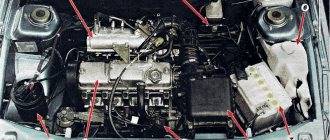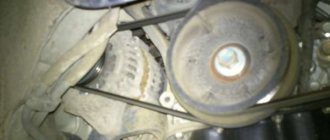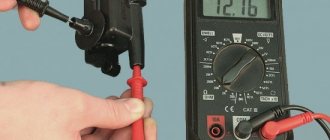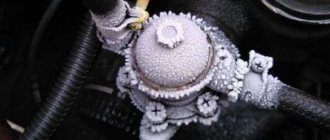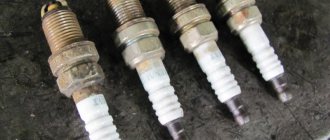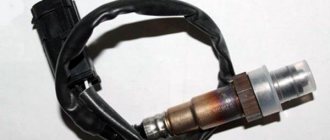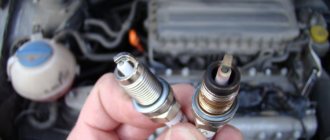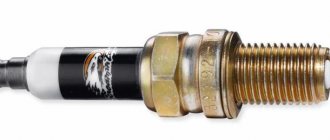The invention relates to electrical equipment of cars. The spark plug contains a housing with a side electrode, an insulator in which the central electrode and the contact rod are secured using a conductive sealant, an interference suppression resistor received by a spring to the contact head, wherein the resistor is made of wire with high internal resistance, and the contact head is attached to the insulator using glass, the edges of which are rolled into the annular groove of the insulator. The invention improves the reliability of the spark plug. 1 ill.
The invention relates to electrical equipment for automobiles, in particular to spark plugs for internal combustion engines (ICE).
A spark plug for an internal combustion engine is known, containing a housing with a screen and a side electrode, an insulator installed in the housing with a stepped hole, in which a central electrode with a contact and a liner with a noise suppression resistor are placed in series, and the liner is equipped with a cylindrical body made of insulating material, at the ends of which the upper and bottom terminals [1].
The mentioned spark plug is used only for special engines, it is expensive, has large dimensions, in addition, the resistor is located inside the screen, which complicates the design of the spark plug.
The closest in technical essence to the invention is a spark plug with a resistor, containing a housing with a side electrode, an insulator in which the central electrode and the contact rod are secured with a conductive sealant, a resistor made of a material containing 1 - 30 wt.% tantalum oxide, 63-98 wt.% tin oxide, 0.7-9.9 wt.% antimony oxide, coated with glass with a low melting point [2].
The design of this candle has a number of disadvantages. The resistor consists of a number of chemical compounds, and therefore the nominal value of this resistance has a large tolerance and changes significantly during operation. When the resistance increases, the discharge energy on the spark plug decreases; when the resistance decreases, the resistor does not perform its noise-suppressing functions. In addition, the presence of a threaded connection between the contact head and the insulator complicates the design and impairs the reliability of the spark plug, since during operation the contact head can unscrew itself.
How to modify spark plugs yourself to save fuel
Spark plugs are an essential element of a gasoline engine, creating a spark to ignite the mixture of fuel and air in the combustion chamber. As a rule, the service life of ordinary budget candles is limited to several tens of thousands of kilometers (15-25 thousand), that is, these elements are so-called consumables.
Experienced drivers know well that the stability of engine starting, engine power, fuel consumption and other characteristics directly depend on the quality of spark plugs. It is important to understand that after just a few thousand or even hundreds of kilometers (depending on the general condition of the internal combustion engine, fuel quality, etc.) the spark plugs begin to work less efficiently.
As a result, the engine begins to “pull” worse, the driver presses the gas harder, while more fuel in the cylinders still burns less fully. In other words, there is an increased consumption of gasoline. It is for this reason that many drivers practice modifying spark plugs to save fuel, which we will talk about next.
Why do you need to modify spark plugs?
Let's start with the fact that owners of old gasoline cars, mainly carburetor ones, should modify new spark plugs for good economy and increased power. As a rule, it is on such a dosing system that the issue of gasoline consumption is most acute.
In parallel with this, modifications can have a positive effect on the injector. At the same time, high-tech modern spark plugs with an extended service life (platinum, iridium) should not be modified. It turns out that changes and improvements are most relevant only in relation to ordinary candles. Now let's take a look at the practical benefits of improving candles.
- First of all, ease of starting and, as a result, less risk of flooding the spark plugs. This is especially true in winter, when fuel evaporates less easily in a cold engine, the battery charge naturally drops, the oil becomes sticky and the starter turns the engine weaker.
- Another advantage that “tuning” spark plugs promises is stable operation of the internal combustion engine in different modes, (especially at maximum loads and high speeds), even taking into account that the composition of the fuel-air mixture will not be optimal, that is, the working mixture is too lean or enriched.
- Note that under conditions of high pressure on modified spark plugs, less impact is exerted on the spark, which is simply blown away on a standard spark plug. As a result, the power unit not only starts well, but also burns the fuel charge more fully, delivering more power. This reduces fuel consumption and results in savings.
Do-it-yourself modification of spark plugs
The modernization is based on the task of bringing simple spark plugs closer in a number of parameters to the so-called sports spark plugs. Such products are offered by many well-known manufacturers, but they are significantly more expensive.
Sports spark plugs allow you to increase power and reduce consumption; the declared service life of such elements is 70-90 thousand km. mileage However, in practice, the efficiency of their work decreases, on average, after 15 thousand km, and such spark plugs do not last the entire stated period. Taking into account the high cost, buy these elements every 30-35 thousand km. it turns out to be expensive.
It is for this reason that many drivers do not strive to immediately change a set of spark plugs, since there are ways to extend the life of existing ones. The best way to solve the problem is to modify conventional or sports spark plugs.
What might be the features of a spark plug with a resistor?
Among the basic features of spark plugs that use resistors are the following:
- Many spark plugs, especially if they are made by the same company that made your car, are often very sensitive to fuel quality , so if you use poor quality gasoline on a regular basis, you run the risk of having to change spark plugs more often .
- Regarding saving resources, it is better to check when purchasing a particular candle, because, as practice shows, even if you buy very expensive candles, this does not mean that you will actually save.
- proven gas stations on a regular basis , or constantly carry a supply of good fuel with you, otherwise your spark plugs may work extremely inconsistently.
- You have to constantly maintain the voltage , because if it is too low, then the stability of the spark in this case is called into question.
The parameters of a spark plug with a resistor can be slightly compared with those of a spark plug that does not have a resistor. However, a spark plug that has a resistor causes more difficulties for the average driver than one without it, since you have to constantly monitor how well it works.
Checking with a multimeter
A universal tester or multimeter helps to quickly check the performance of spark plugs. This device is familiar to many car owners who have had to repair their vehicle. The main purpose of using a multimeter is to detect the presence or absence of a short circuit inside the spark plug.
Read more: Exercise slide on mechanics sequence with handbrake
The multimeter is very easy to use; no special experience or skills are required to use it. For diagnostics, unscrew the conductor, connect one terminal to the spark plug thread, and the second to the central output.
When voltage is applied, a spark should appear, which will indicate that the part is working, otherwise it must be replaced. Checking spark plugs with a multimeter is the most common diagnostic option at home.
If in testing mode the multimeter shows infinite or very high resistance, then the spark plug is considered non-working.
To check the resistance of the spark plug's built-in resistor, set the multimeter switch to 20 kOhm. One probe of the multimeter touches the central electrode, the other touches the contact terminal.
The resistance of all candles should be approximately the same with a slight spread. For spark plugs of injection engines, the resistor resistance is about 4 kOhm.
Spark plug
The spark plug is a device for igniting the fuel-air mixture in a wide variety of heat engines and the most capricious part in a motorcycle. The spark plug performs a simple function in a complex environment. A reliable electrical discharge must occur at the electrodes of the spark plug, capable of reliably igniting the combustible mixture. But if you've been watching TV lately, you've probably seen advertisements for spark plugs that do or improve literally everything, with the possible exception of curing warts.
Spark Plug Parts
1. Insulator - This white, shiny aluminum oxide ceramic can withstand a melting point higher than that of -steel. (This is the part that always breaks when we are careless with the key when unscrewing the spark plug) The part of the insulator that is in the combustion chamber can heat up to 1000 degrees. C (with early ignition).
2. Central electrode - usually consists of 2 parts. The upper one is steel, and the lower one that we see is made of nickel. Nickel is electrically stable and can withstand temperatures of 1400 degrees C.
3. Contact post - This part may have a built-in or replaceable shaped nut. Make sure it is screwed securely.
4. Base - This is the part that has the threads that hold the spark plug in the cylinder head. The base is made of ordinary steel, and then plated with zinc or nickel.
5. Ground electrode - usually shaped like an "L" at the business end of the spark plug. This area is where all the latest advances are concentrated.
Spark plug testing
Various standard tests are necessarily carried out on spark plugs to establish their specific characteristics and operating temperature ranges. These include the IMEP test, which measures the average effective sensitivity to high pressure, a thermal leak test, an insulator fouling test, a spark analyzer, which uses an oscilloscope to determine the degree of ionization of the spark gap, and electrode spark erosion tests to measure possible spark plug wear. All these tests are carried out only in factory conditions, and are not used by racers. Typically, the operating temperature range of spark plugs for map engines corresponds to the recommended one.
Spark plug markings
Labeling information to help you understand the difference between spark plugs.
The marking consists of six fields like: [C] [CPR] [9] [E] [S] - [11] Some of them are optional, for example the second and last.
First field: Thread diameter. A = 18mm B = 14mm C = 10mm D = 12mm
Second field: Construction. C = 5/8″ spanner K = 5/8″ spanner (with projected tip) (not sure what it is) (ISO) M = compact type P = projected insulator type R = resistor SD = surface discharge for rotary engines U = semi-surface discharge Z = inductive suppressor (too lazy to translate the markings, which are rarely found on motorcycles)
Third field: Temperature range. 2 = hottest, 10 = coldest. Well, the rest of the numbers are intermediate values.
Fourth field: Thread length. E = 19mm F = tapered seat H = 12.7mm (1.5″) L = 11.2mm (7/16″)
If this field is empty, then for a thread with a diameter of 18mm its length is 12mm, and for a thread with a diameter of 14mm it is 9.5mm (3/8″).
Fifth field: Electrode design. A, B = special design (no details given) C = special ground electrode G = racing use GV = racing use V type H = half thread IX = iridium electrode K = 2 ground electrodes for certain Toyotas L = half heat range LM = compact lawn mower type M = 2 ground electrodes for Mazda rotary engine N = special ground electrode P = platinum tip (premium) Q = 4 ground electrodes R = delta ground electrode for BMW S = standard 2.6mm center electrode T = 3 ground electrodes V = fine-wire center electrode, gold palladium VX = platinum tip (high performance) W = tungsten electrode X = booster gap Y = v-groove center electrode
Again, too lazy to translate a lot of terms. Conventional spark plugs with a large diameter central electrode and one outer electrode do not contain anything in this field. Iridium ones are marked IX.
Sixth field: (after the dash) The width of the gap between the electrodes. 8 = .032″ 9 = .036″ 10 = .040″ 11 = .044″ there is no 12 13 = .050″ 14 = .055″ 15 = .060″ 20 = .080″
If not specified, then 0.7 ... 0.8 mm
PS Spark plugs with and without a resistor differ in that spark plugs with a resistor do not require one in the ignition coil. A resistor is needed so that the spark plug does not cause electrical interference in the on-board electrical network and to provide more rectangular pulses in the ignition coil, which is especially important for high-speed engines.
What is a spark? How does the mixture ignite? First of all, remember that at the moment of ignition the combustion chamber is filled with a compressed combustible mixture. That is, gases that have insulating properties. In order for a spark to be able to break through the normal spark gap between the electrodes of the spark plug, which is 0.7...0.8 mm, even at atmospheric pressure, a voltage of about 2...3 thousand volts is required. It's in the air! Under the spark plug, at the end of the compression stroke, the pressure is much higher, and therefore it is much more difficult to break through the gap; the voltage must be applied 5-6 times more! And in order to guarantee reliable sparking, the ignition system must also have a reserve, i.e. its coefficient reliability must be greater than one. If this system works normally, then a spark jumps between the electrodes of the spark plug—a column of ionized gas (plasma) is formed, which is a conductor. Along this column, as if through a channel (and this is what experts call a channel!), the electricity accumulated in the corresponding elements of the system is discharged. The gas temperature in the channel is about 1800° C, which is several times higher than the temperature of the gasoline-air mixture. And therefore the mixture ignites not only in the channel, but also at some distance from it, around it, where in this short moment it manages to heat up to the ignition temperature. This primary focus will be larger the more powerful and longer the discharge. It would seem that there is a direct meaning to increase the gap between the electrodes and lengthen the spark. But then you will need to increase the power of the ignition system. This is unacceptable for a number of reasons. Therefore, on less forced engines, where the pressure in the combustion chamber is lower, the gap between the electrodes can be increased to 0.8...0.9 mm, and on more forced ones, reduced to 0.5...0.6 mm. By the way, experienced motorcyclists, even without knowing this whole theory, in a purely practical way came to a simple truth: when the battery is very discharged, to start the engine, you need to reduce the gap between the electrodes of the spark plug to 0.3...0.4 mm. Often this is the only way to “revive” the engine.
Symptoms of a problem
It is almost impossible to visually determine that there are problems with the current supply in the car. To diagnose, you should start the engine or drive the equipment at high speeds.
Read more: Interior air temperature controller 11186 8128070
Before checking the ignition module, you should clearly know the symptoms of the “disease”. So, the first signals about problems with spark plugs:
- The vehicle's crankshaft rotates at the required speed, but the engine does not start. Due to the lack of a spark, there is no ignition of the combustible mixture;
- alternate flashes and fires occur in one or more cylinders, and as a result the engine operates unstable and chaotically;
- The power unit operates when the car starter rotates. When the “trigger” stops rotating, the unit stalls;
- a sharp loss of the machine’s power potential and, as a consequence, increased fuel consumption;
- failure of the catalyst due to a large amount of unburned fuel inside the segment;
- a long process of starting the engine during periods of medium and low outside temperatures. At this time, a large amount of moisture collects on the outer walls, which does not allow the spark of the candle to pass through;
- all kinds of mechanical damage to the spark plug body, which leads to an unstable supply of current to the combustion chamber for ignition.
If there are pronounced black carbon deposits on the spark plug housing, this indicates a malfunction in the power and fuel supply system. Problems with ignition timing can also be caused by worn-out power system wires .
Reduced power and increased gas mileage
These consequences are among the most “harmless”, although operating the engine in abnormal mode leads to serious complications in the long term. Externally, all spark plugs are almost the same: a steel cylindrical body with threads, a ceramic insulator and one or more electrodes. However, the properties of the materials used in the production of each element of the candle make candles that are identical in appearance different. That is why even the installation of serviceable, but non-compliant spark plugs can lead to a decrease in engine power and an increase in fuel consumption.
In accordance with modern trends in engine design, engineers strive to achieve maximum efficiency while simultaneously reducing the size and weight of the units. Requirements for all parts, including candles, are changing rapidly in such conditions. The temperature of the gases in the combustion chamber can reach a thousand degrees or more, which represents a high temperature load. Lean-burn operation requires high voltage, up to 35 thousand volts, to produce a spark. This condition requires new dielectric properties from insulators and seals.
In an effort to meet the ever-increasing demands of automotive companies, leading spark plug manufacturers are introducing new materials into the technological process and improving production. Thus, candle bodies today are produced using cold plastic molding technology. This requires the use of automated machines and a press that develops a pressure of more than one hundred tons. Ceramic insulators that meet the requirements are obtained in compliance with a technological sequence, including grinding the mixture, molding the product and firing. Equally important are the accuracy of assembly, installation of a high-temperature seal and hermetically sealed casing. Another important factor is the composition of the resistive powder that is used to fill the spark plug cavity. The filler ensures stable electrical contact during large temperature changes that are inevitable under conditions of maximum power. Technological processes and material properties are the subject of continuous development, requiring significant investments from manufacturers.
Cleaning spark plugs
Many novice car owners are faced with the problem of cleaning spark plugs. Careless handling may damage the product or render it inoperable. When cleaning spark plugs with your own hands, use the following generally accepted methods:
- manual: a metal brush, rags, toothbrush will be useful. Using light movements around the base, we remove carbon deposits, bringing the product to its standard form. If necessary, use a solvent to remove carbon deposits;
- river sand, which can be taken from any beach or pond. Apply a small amount of sand to a rag and gently wipe the base until completely free of waste products;
- The sandblasting machine is used in service centers and repair shops. There, sand is supplied under high pressure, along with compressed air;
- acetone or other rye cleaner. You can purchase it at any auto store or car market;
- Some people use regular Coca-Cola, but its effectiveness has not been conclusively confirmed.
As you can see, checking spark plugs requires very little time, effort and money. Just 10 minutes is enough, and your car will be in full combat readiness. Follow the recommendations of the article, check the color of the spark, then everything will be fine.
Unstable operation of the motor can be caused by a malfunction of the gearbox, the condition of which cannot always be assessed by visual inspection, especially if the product is covered with a large amount of carbon deposits or its body is damaged. What resistance should be on the spark plugs and how to make a tester for these products with your own hands you will learn from our article.
Read more: Heated seats Niva Chevrolet article number
